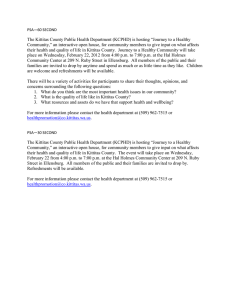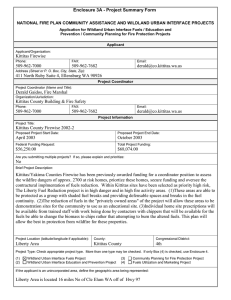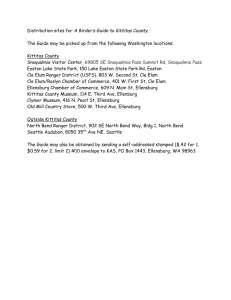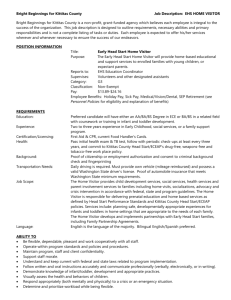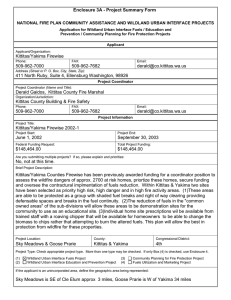Enclosure 3A - Project Summary Form
advertisement
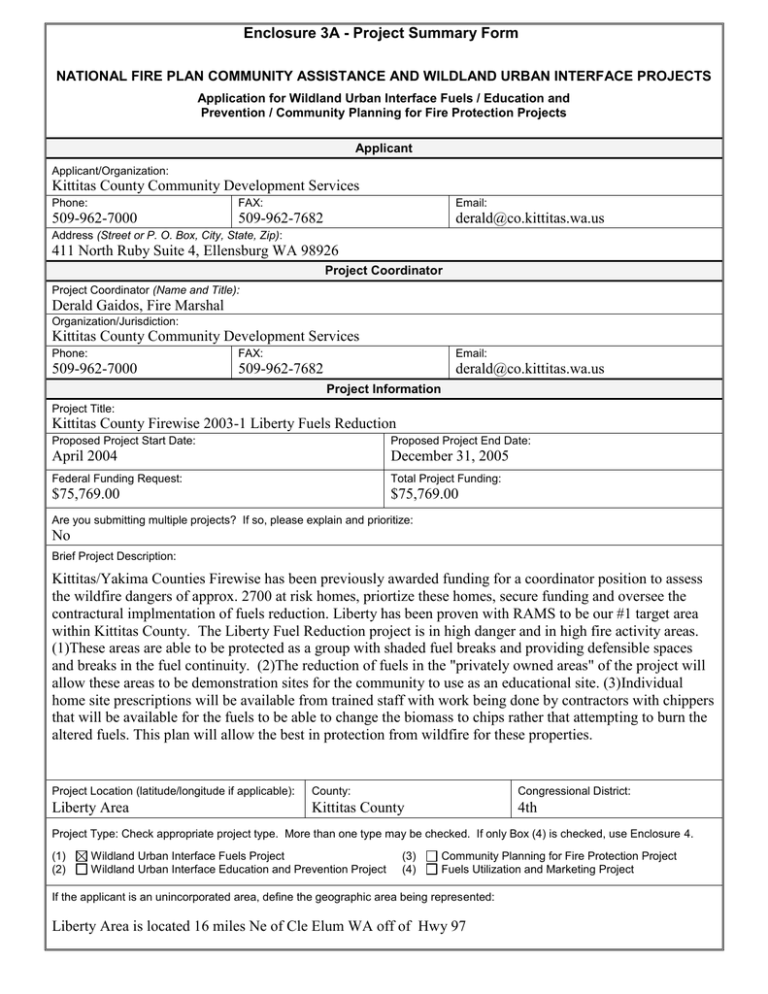
Enclosure 3A - Project Summary Form NATIONAL FIRE PLAN COMMUNITY ASSISTANCE AND WILDLAND URBAN INTERFACE PROJECTS Application for Wildland Urban Interface Fuels / Education and Prevention / Community Planning for Fire Protection Projects Applicant Applicant/Organization: Kittitas County Community Development Services Phone: FAX: Email: 509-962-7000 509-962-7682 derald@co.kittitas.wa.us Address (Street or P. O. Box, City, State, Zip): 411 North Ruby Suite 4, Ellensburg WA 98926 Project Coordinator Project Coordinator (Name and Title): Derald Gaidos, Fire Marshal Organization/Jurisdiction: Kittitas County Community Development Services Phone: FAX: Email: 509-962-7000 509-962-7682 derald@co.kittitas.wa.us Project Information Project Title: Kittitas County Firewise 2003-1 Liberty Fuels Reduction Proposed Project Start Date: Proposed Project End Date: April 2004 December 31, 2005 Federal Funding Request: Total Project Funding: $75,769.00 $75,769.00 Are you submitting multiple projects? If so, please explain and prioritize: No Brief Project Description: Kittitas/Yakima Counties Firewise has been previously awarded funding for a coordinator position to assess the wildfire dangers of approx. 2700 at risk homes, priortize these homes, secure funding and oversee the contractural implmentation of fuels reduction. Liberty has been proven with RAMS to be our #1 target area within Kittitas County. The Liberty Fuel Reduction project is in high danger and in high fire activity areas. (1)These areas are able to be protected as a group with shaded fuel breaks and providing defensible spaces and breaks in the fuel continuity. (2)The reduction of fuels in the "privately owned areas" of the project will allow these areas to be demonstration sites for the community to use as an educational site. (3)Individual home site prescriptions will be available from trained staff with work being done by contractors with chippers that will be available for the fuels to be able to change the biomass to chips rather that attempting to burn the altered fuels. This plan will allow the best in protection from wildfire for these properties. Project Location (latitude/longitude if applicable): County: Congressional District: Liberty Area Kittitas County 4th Project Type: Check appropriate project type. More than one type may be checked. If only Box (4) is checked, use Enclosure 4. (1) (2) Wildland Urban Interface Fuels Project Wildland Urban Interface Education and Prevention Project (3) (4) Community Planning for Fire Protection Project Fuels Utilization and Marketing Project If the applicant is an unincorporated area, define the geographic area being represented: Liberty Area is located 16 miles Ne of Cle Elum WA off of Hwy 97 Enclosure 3B (Page 1 of 3) - Project Narrative Description Applications for funding must include a narrative response that describes the proposal. Please do not submit responses longer than one page, single space, 12-pitch font. Describe project including, but not limited to: project location Address these project implementation items as anticipated outcomes applicable: measures and reporting interagency partners project relationship to community or natural landscape fire plans project time frames and income specify types of activities and equipment used amount or extent of actions (acres, number of homes, etc) environmental, cultural and historical resource requirements Kittitas County Firewise Grant 2003-01 (Liberty Fuel Reduction) is to implement fuel reduction at priority high risk, high danger, high fire activity areas. This site has problems and conditions that have prioritized via RAMS as a site needing immediate attention. In the past 120 years this development has done little to remove the fuels that have continued to grow since the developments were first founded. At the time of inception these developments were never thought to be anything other than for mining use. As years have passed the homes have become larger, become fulltime recreational and even full-time residents. With the buildout of the home sites, being supplied with substandard road systems, water systems that were for domestic use only with no planning for fire flow or even a fire department, and building construction types that were not designed for the fire resistivity, the fire danger has increased dramatically. This project is predicated from a RAMS evaluation (2003) proving the need. Within Kittitas County the anticipated outcome of the project is reduced ground fuels that will allow the fire proofing of these developments. The partners of this project will be: Liberty Home Owners Association, Liberty Mt. Home Owners Association, USFS, DNR, Kittitas County Community Development Services, Kittitas County Fire Districts #1, #2, #3, #4,#5, #6, #7, #8, Cle Elum Fire, Ellensburg Fire, Roslyn Fire, S. Cle Elum Fire Departments, as each department would be in a mutual aid situation as the private land holders are surrounded by USFS land. The time frame to start the project is in the Spring of 2004 and finish in the Fall of 2005. Approx. 75 homes will be protected by this project of mechanical and hand fuel reduction work. The National Fire Plan will be supported by the interagency attempt to reduce fuel loading at sites where previous lack of fire planning efforts have lead to less than favorable firesafe sites within Kittitas County putting all at risk who live there and all that would respond to these locations. This project had previously be approved and was not funded due to budget concerns. As the 2003 Fire Season is approaching, the urgency to implement this plan is utmost. If the fire season does not directly impact these homeowners associations by way of fires, the teachable moments of last few years of drought should be used before a year of normal precipitaion clouds the dangers of wildfire with the dangers being passed on to the next dry year. The fire dangers will never leave these developments without fuel reduction programs to lessen the transmission of wildfire. The roads, water system and houses are already in place. We can alter some of the variables but most are cemented in stone. Fuel reduction in a constructive manner will allow the public to enjoy their property and still be in as safe as possible within developed areas. The fuel reduction will give a distancing of fuels on forested lands to protect the very large USFS landholding in the tributaries above the developments. By using chippers to reduce the fuels to another biomass state, the enviromental aspect of the project will enhance the forest. By chipping the biomass it takes the need out of burning the residue and lessens possible accidental fire starts and returns the nutrements to the forest floor will halting the growth of small brush plants via the "beauty bark syndrome". Liberty is a Gold Mining location that has been in existance scince the 1880's. Its historical and cultural importance are documented in many actions that have taken place to preseve this small historical district from legal problems in the 1970's to repeal the take over of the district from the federal goverment. Again on 9-1489 a forest fire burned 140 acres ajoinined the area nearly destriying the area. Liberty has formed a historical district that allows home and or structures to be built under strict guidelines that include clearing around new homes and fireproof roofing due to the fire of 1989. Response: Enclosure 3B (Page 2 of 3) - Project Evaluation Criteria Applications for funding must include narrative responses that address the following four criteria. Within each criterion, subcriteria are listed in descending order of importance. Limit your responses to the areas provided. 1. Reducing Fire Risk. (40 points)) A. Describe how the proposal promotes reduction of risk in high hazard areas or communities, or natural landscapes. B. Describe how the proposed project benefits resources on federal land or adjacent non-federal land, or how it protects the safety of communities. C. To what extent does the project implement or create a cooperative (1) fuels treatment plan or (2) community fire strategy (include evidence of the plan if it already exists)? D. Explain to what extent the affected community or proponent has been involved or plans to involve the affected community in a qualified fuels education program (e.g., FIREWISE). E. Explain how the proposal (1) leads to, enhances or restores a local fire-adapted ecosystem, and/or (2) mitigates or leads to the mitigation of hazardous fuel conditions. F. How will the proposed treatments or programs be maintained in future years? Response: : Kittitas 2003-1 is in high hazard, high risk, high fire activity areas. By reducing the dangers of transmission of fire between homes and wildland, risk to surrounding areas will be lessened. By reducing the fuels of the developments, the paths of evacuation will be made safer. With the chance of slowing and or stopping the fire in a treated area of the development the spread of the fire would be controlled by the shaded fuel break/defensable space. The proposed work is in an area already atune to the fire dangers. The Liberty Area had fire losses in 1989, were effected by the drought of 2001-03 and experienced the effects of large scale fires from the fires of Washington State in 1994 & 2001 . This project would follow the National Fire Plan by reducing fire risk, increasing local capacity, expanding community participation and increasing interagency coordination. Both Kittitas County Employees and Liberty Homeowners Association represenatives have participated, hosted and been speakers at FIREWISE Community Workshops within Washington State. This plan will allow for mitigation of the removal of biomass from one state to another. The chips spread on the forest floor will inhibit growth, provide for moisture retention, add to erosion control and soil enhancement. The owners of the land will be in charge of the maintenance of the fuel breaks for future considerations. 2. Increasing local capacity. (30 points) A. How would the proposal improve or lead to the improvement of the local economy in terms of jobs and sustainable economic activity? How many jobs are expected to be created or retained and for how long (please distinguish between essentially yearround and seasonal jobs)? How will this proposal link to toher projects (or proposed projects) to create year-round jobs? B. To what extent will this project be offered to serve as a model for other communities or natural landscapes? C. Will biomass or forest fuels be utilized; if so, in what manner and how much? Response: The project will educate the public and the homeowner associations while treating the ground fuels in the high risk development locations. These homeowners in this developmen/subdivision will have the fuel treatment done to common areas and ajacent to structures. While the areas have many such developments, the trickle down of jobs is expected, as education furthers, the need for fuel reduction will increase. Fuel treatment work is expected to support 4-6 jobs in the area. These contractors are displaced timber workers who have changed their jobs and are using previous skills to maintain an income. The expected extent of the job outlook is for a minimum of 5 years and then an ongoing maintenance of the treated fuel areas. These jobs are weather related and seasonal. All reports and records are available to any and all agencies upon request. At this time staff working on these projects within Kittitas County are asked to be guest speakers through out Washington State. We have used information from other jursidictions and feel strongly about the positive effects of sharing information. At this time all chipped material is placed back on the forest floor due to lack of marketability of this low grade chip from industry. If a landowner requests the chips be removed that is done and used other places within Kittitas County. Market changes would and could make the biomass chips a marketable product in the future. Enclosure 3B (Page 3 of 3) - Project Evaluation Criteria 3. Increasing interagency and intergovernmental coordination. (15 Points) A. Describe how this project implements a local intergovernmental strategy or plan, or creates such a plan. Describe the plan if it already exists. B. Explain the level of cooperation, coordination or strategic planning through a “Local Coordination Group” for wildland fire activities, or among federal, state, tribal, local government and community organizations. List the cooperators (a detailed list of cooperators will be required for projects that are funded). Response: At this time K2003-1 in a location that has good working relationships with responding agencies both local, state and federal. In new proposals of sub-divisions within the urban interface areas, the process is such that comments are gathered from all agencies to allow the latest available best common practices to be used to protect the residents of the new as well as surrounding developments. Our older developments are approaching buildout and these developments are less than firesafe. Re-building roads and altering structures is impratical due to costs. Fuel reduction is the only possible way to firesafe these areas practically speaking. We in Kittitas County are tackling the Urban Interface Wildfire as piority in our problem solving efforts. By having a controlling effort on the new development and a effort to solve past problems we believe that the wildfire issue could be controlled as much as possible with the implementation of these projects. Local FD's and interested persons have tried to lead the effort to do something with these dangerous fire areas for years. Recent years have shown that fuel reduction is in effect, mimicking fire with the results that promote good forest health. The partners of this project will be: Liberty Home Owners Association, Liberty Mountian Home Owners Associations along with USFS,Washington State Fish & Wildlife, WADNR, Kittitas County Community Development Services, Kittitas County Fire Districts #1, #2, #3, #4,#5, #6, #7, #8, Cle Elum Fire, Ellensburg Fire, Roslyn Fire, S. Cle Elum Fire Departments. 4. Expanding Community Participation. (15 Points) A. To what extent have interested individuals, groups, and communities been provided an opportunity to become informed and involved in this proposal? B. Describe the extent of local support or opposition for the project, including any cost-sharing arrangements. C. What are the environmental, social and educational benefits or concerns of the project? have been held at sites promoting fire safety and at the 4th of July 2002 celebration materials and speakers were present to address fire safety. They understand the dangers that are within their development and have started taking steps to make it a safer place via increasing some individual fuel reductions and individual fire pump systems. Meeting of these groups have lead to plans being formed awaiting funding. A 2001 FIREWISE project was done in the Upper Kittitas County with a coordinator that did contractural, public and media projects. The ability of an individual homeowner to receive a prescription was also done by the coordinator, training prescription writters to do individual home prescriptions. The Kittitas County Fire Prevention Group was re-formated as Kittitas County FIREWISE Coop with individual, corporate and govermental persons being involved. This Coop is meeting once a month and has held a FIREWISE worksop in Fall 2001 & Summer 2002, for local persons with good results. Support of these projects is very well received as the need for the fire prevention is very evident. We have a very special connection as four wildland fire fighters who died in 2001 in Winthrops 30 Mile Fire were from Central Washington, with one local man being from Kittitas County. Our county is very sensitive about wildfires, and at this point we have a teachable moment to utilize. In-kind work for this project will be tracked for future reference and study. The project will chip all product thus lessening the dangers of fire and promoting clean air. Response: Public meetings Enclosure 3C - Project Work Form Tasks Time Frame Responsible Party Recieve approval of funding Fall 2003 USFS/Federal Goverment Recieve Funding Fall 2003 USFS/Federal Goverment Meeting of all partners in project, scope of work, finalize plans, prepare bids, advertize bids Funding + 45 days Kittitas County Firewise Open Bids, hire contractor start work April 2004 Kittitas County FireWise Complete Work and end contract October 2005 Contractor & Kittitas County Firewise Group. Top of Form Enclosure 4D - Project Budget Cost Category Description Federal Agency Personnel $0.00 Subtotal $0.00 Applicant Partner 1 Partner 2 $0.00 $0.00 $0.00 $0.00 $0.00 $0.00 $0.00 $0.00 $0.00 $0.00 $0.00 $0.00 $0.00 $0.00 $0.00 $0.00 $0.00 $0.00 $0.00 $0.00 $0.00 $0.00 $0.00 $0.00 $0.00 $0.00 $0.00 $0.00 $0.00 $0.00 $0.00 $0.00 $0.00 Fringe Benefits Subtotal $0.00 $0.00 $0.00 Travel Subtotal $0.00 $0.00 $0.00 Equipment Subtotal Supplies maps (inkind) mailings Subtotal $0.00 $0.00 $0.00 $0.00 Contractual Contractor $0.00 Subtotal $0.00 $0.00 $0.00 $0.00 $0.00 $0.00 $0.00 $0.00 Other grant $75,769.00 Subtotal $75,769.00 $0.00 $0.00 $0.00 $0.00 $75,769.00 $0.00 $75,769.00 Total Costs $75,769.00 $0.00 $0.00 $0.00 $75,769.00 Project (Program) Income1 1 Total Program income is the gross revenue generated by a grant or cooperative agreement supported activity during the life of the grant. Program income can be made by recipients from fees charged for conference or workshop attendance, from rental fees earned from renting out real property or equipment acquired with grant or cooperative agreement funds, or from the sale of commodities or items developed under the grant or cooperative agreement. The use of Program Income during the project period may require prior approval by the granting agency. $0.00
